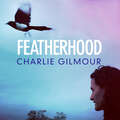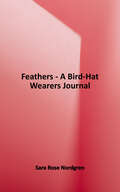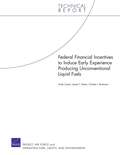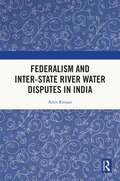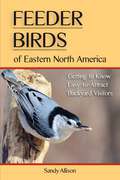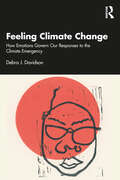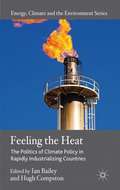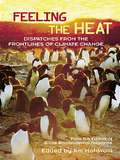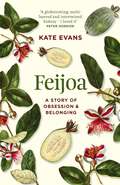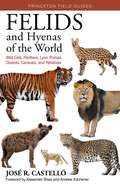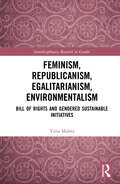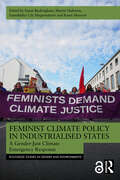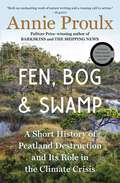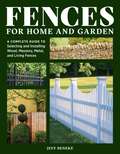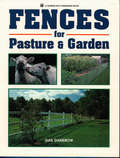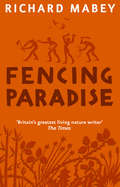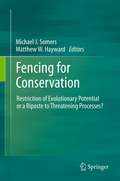- Table View
- List View
Feather Trails: A Journey of Discovery Among Endangered Birds
by Sophie A. OsbornNamed ABA Birding Book Club&’s Best Book of the Year&“[This book] deserves to be read widely, because it is only in coming to understand these animals, suggests Osborn, that we can choose to love and help them.&”—New ScientistThe story of one woman&’s remarkable work with a trio of charismatic, endangered bird species—and her discoveries about the devastating threats that imperil them.In Feather Trails, wildlife biologist and birder Sophie A. H. Osborn reveals how the harmful environmental choices we&’ve made—including pesticide use, the introduction of invasive species, lead poisoning, and habitat destruction—have decimated Peregrine Falcons, Hawaiian Crows, and California Condors.In the Rocky Mountains, the cloud forests of Hawai&’i, and the Grand Canyon, Sophie and her colleagues work day-to-day to try to reintroduce these birds to the wild, even when it seems that the odds are steeply stacked against their survival.With humor and suspense, Feather Trails introduces us to the fascinating behaviors and unique personalities of Sophie&’s avian charges and shows that what endangers them ultimately threatens all life on our planet.More than a deeply researched environmental investigation, Feather Trails is also a personal journey and human story, in which Sophie overcomes her own obstacles—among them heat exhaustion, poachers, rattlesnakes, and chauvinism.Ultimately, Feather Trails is an inspiring, poignant narrative about endangered birds and how our choices can help to ensure a future not only for the rarest species, but for us too.&“An intimate look at the wonder and effort needed for working with endangered species in the wild. [Osborn&’s] matter-of-fact writing style and wry humor make the reader part of the action.&”—Booklist (starred review)
Feathered Dinosaurs: The Origin of Birds
by John A. Long Peter SchoutenScientists have recovered more than a billion fossils, but no discovery has been more breath-taking than the fossils recently found in northern China, findings which prove that several families of dinosaurs had feathers, or feathery hair-like coverings, adorning their bodies. Now in the beautifully designed Feathered Dinosaurs, paleontologist John Long and illustrator Peter Schouten provide a stunning visual record of these extraordinary prehistoric creatures, illuminating the evolutionary march from primitive, feathered dinosaurs through to the first true flying birds. Schouten, an acclaimed natural history artist, has created 80 full-color paintings that capture the striking physical traits of these feathered dinosaurs. Drawing on his extensive knowledge of the lifestyles of modern birds and mammals, plus the extant scientific data regarding how these dinosaurs might have looked and behaved, Schouten has produced not only the most beautiful but also the most accurate visual representations of these animals in print. Equally important, John Long, a noted paleontologist and widely published science author (with some 24 books to his credit), provides an engaging companion text that places these feathered dinosaurs within the larger family of dinosaurs--for instance, outlining their relationship to T. Rex and Velociraptor, species well known to Jurassic Park fans--and discusses the factual information that can be deduced from their fossil remains, in effect providing an insightful natural history of this remarkable group. A true marriage of art and science, Feathered Dinosaurs presents an unprecedented visual record of one of the most significant breakthroughs in the history of vertebrate paleontology--the discovery that many predatory dinosaurs were cloaked with feathers, perhaps just as colorful and fanciful as those of their living relatives.
Featherhood: 'The best piece of nature writing since H is for Hawk, and the most powerful work of biography I have read in years' Neil Gaiman
by Charlie Gilmour'One of the best books I have ever read. Incredibly moving' Elton John'I cant recommend it too highly' Helen Macdonald'Ranks among the best modern coming-of-age memoirs' Sunday Times'Where Helen Macdonald's H Is For Hawk meets Gerald Durrell's My Family And Other Animals ... Remarkable' Daily Mail'Beautiful, wise, compassionate and powerful' Isabella TreeThis is a story about birds and fathers.About the young magpie that fell from its nest in a Bermondsey junkyard into Charlie Gilmour's life - and swiftly changed it. Demanding worms around the clock, riffling through his wallet, sharing his baths and roosting in his hair... About the jackdaw kept at a Cornish stately home by Heathcote Williams, anarchist, poet, magician, stealer of Christmas, and Charlie's biological father who vanished from his life in the dead of night.It is a story about repetition across generations and birds that run in the blood; about a terror of repeating the sins of the father and a desire to build a nest of one's own. It is a story about change - from wild to tame; from sanity to madness; from life to death to birth; from freedom to captivity and back again, via an insane asylum, a prison and a magpie's nest.And ultimately, it is the story of a love affair between a man and a magpie. 'An incisive, funny and at times traumatic study of the damage done by destructive father-son relationships and the struggle to smash generational cycles' Evening Standard'A personal reckoning which is simultaneously brutal and joyous. I was entranced' Cathy Rentzenbrink'A beautiful book - it made me cry' Simon Amstell
Featherhood: 'The best piece of nature writing since H is for Hawk, and the most powerful work of biography I have read in years' Neil Gaiman
by Charlie Gilmour'One of the best books I have ever read. Incredibly moving' Elton John'I cant recommend it too highly' Helen Macdonald'Ranks among the best modern coming-of-age memoirs' Sunday Times'Where Helen Macdonald's H Is For Hawk meets Gerald Durrell's My Family And Other Animals ... Remarkable' Daily Mail'Beautiful, wise, compassionate and powerful' Isabella TreeThis is a story about birds and fathers.About the young magpie that fell from its nest in a Bermondsey junkyard into Charlie Gilmour's life - and swiftly changed it. Demanding worms around the clock, riffling through his wallet, sharing his baths and roosting in his hair... About the jackdaw kept at a Cornish stately home by Heathcote Williams, anarchist, poet, magician, stealer of Christmas, and Charlie's biological father who vanished from his life in the dead of night.It is a story about repetition across generations and birds that run in the blood; about a terror of repeating the sins of the father and a desire to build a nest of one's own. It is a story about change - from wild to tame; from sanity to madness; from life to death to birth; from freedom to captivity and back again, via an insane asylum, a prison and a magpie's nest.And ultimately, it is the story of a love affair between a man and a magpie. 'An incisive, funny and at times traumatic study of the damage done by destructive father-son relationships and the struggle to smash generational cycles' Evening Standard'A personal reckoning which is simultaneously brutal and joyous. I was entranced' Cathy Rentzenbrink'A beautiful book - it made me cry' Simon Amstell
Feathers of Hope: Pete Dubacher, the Berkshire Bird Paradise, and the Human Connection with Birds (Excelsior Editions)
by Barbara ChepaitisFeathers of Hope takes the reader on a joyful journey through the Berkshire Bird Paradise in Grafton, New York. Founded and maintained by Pete Dubacher, the Berkshire Bird Paradise is a magical place that provides sanctuary to over twelve hundred injured or otherwise unreleasable birds, from emus, pigeons, and tropical birds to eagles, owls, hawks, and more. New York City residents regularly drive four hours to hand-deliver injured pigeons to Pete, and wildlife officials across the country have sent injured birds for his care, from an eagle mauled by a bear in Alaska to cranes left over from a breeding program in Maryland. In April 1999, two baby golden eagles were hatched from two disabled birds, and the surviving eaglet, Dotty, was successfully released into the wild, and in 2003 two bald eagles were, for the first time ever, hatched in captivity, raised, and released.Following Pete for a "typical" day at the sanctuary, which includes tossing dead rats to eagles and stoking woodstoves at one in the morning, author Barbara Chepaitis provides an intimate view of what it takes to maintain a dream of this proportion, and what makes Pete Dubacher the kind of man who can do so. Along the way, she also tells the stories of other people in many different walks of life who have found solace in and taken inspiration from their interactions with birds, including a college student who takes an injured baby bird to her critical theory class, avid birdwatchers who keep careful lists of all the birds they've seen, and a man who found meaning by rescuing injured pigeons in New York City. Together with Pete's story and the story of the Berkshire Bird Paradise, their stories offer an engaging look at how forging a stronger connection to birds, and to nature in general, can teach us to be more fully human. Birds of Paradise is for anyone who ever rescued a baby bird or wondered how to make a dream come true.
Feathers: A Bird-Hat Wearer’s Journal
by Sara Rose NordgrenDesigned as a turn-of-the-century women's magazine that combines memoir, history, theory, poetry, and image, this book explores women's complex relationship with birds through the history of feather fashion. Originating in the bird-hat controversy of the late 19th and early 20th centuries, which coincided with both the women's suffrage and budding American conservation movements, this polyvocal book moves in multiple directions as it examines cases of women and birds from across cultures and time periods, from the Virgin Mary, to Leda, Swan Lake, and Alexander McQueen. As its connective thread, Feathers also follows one woman's enculturation into the world of bird women and its inherent violence.
Feathers: Displays of Brilliant Plumage
by Robert ClarkThe award-winning National Geographic photographer captures the stunning variety and mystery of bird feathers in this acclaimed monograph.Robert Clark’s fascinating and brilliantly colorful images reveal the beauty and myriad functions of a seemingly simple thing: the bird feather. Each exquisitely detailed close-up is paired with informative text about the utility and evolution of the feather it depicts, making this handsome marriage of art and science the ideal gift for bird lovers, natural history buffs, and photography enthusiasts.“Art meets science in a poetic celebration of Earth’s astonishing diversity. Feathers is an intensely beautiful visual taxonomy and a photographic love letter to this poetic feat of evolution.” —Brain Pickings
Federal Financial Incentives to Induce Early Experience Producing Unconventional Liquid Fuels
by Frank Camm James T. Bartis Vi-Nhuan Le Charles J. BushmanThe government, as a principal, may seek to induce a private investor, as anagent, to build and operate an unconventional-oil production plant topromote early production experience with such plants. Facing significantuncertainty about the future, it also wants to limit the cost to the publicof doing this. This report offers an analytic way to design and assesspackages of policy instruments that the government can use to achieve itsgoal.
Federalism and Inter-State River Water Disputes in India
by Amit RanjanThis book examines the Union-State and inter-State relations concerning water issues in India. It analyses the federal structure in India and looks at its effectiveness in addressing the inter-state river water disputes in the country through three cases: the Cauvery, Krishna and Mahadayi Rivers water dispute. It probes into the physical, political, legal and constitutional measures taken by the Union government and the states to deal with the inter-State and Union-State tussles over inter-State river waters. The author studies the debate over centralisation and decentralisation of water resources, as well as the inter-state river water disputes that have aroused feelings of sub-nationalism in many regions of India. Finally, this book also examines socio-political tensions over multipurpose water projects and other supply-side infrastructures, and their efficacy in addressing India’s increasing water problems. This book will interest researchers and students of Environmental Politics, Political Science, Public Policy, Environmental Geography, Indian Politics, South Asian Studies, Environmental Economics, Environmental Policy, River Management, and Resource politics.
Feeder Birds of Eastern North America
by Sandy AllisonBird-watchers know there is a list of species that regularly and dependably come to dine at backyard bird feeders.
Feeding With Love and Good Sense: The First 2 Years
by Ellyn SatterA good feeding relationship with your child starts at day one and makes all the difference between joy or struggle in feeding. This brief, beautiful, compact, engaging booklet gets today’s busy parents off to a good and authoritative start with feeding. Full of Satter's pithy advice and real-life feeding stories. Gives a concise behavioral and nutritional guide to feeding children, emphasizing what to do in words and pictures, and demonstrating why to do it with feeding stories. The emphasis is on tuning in on, understanding, and feeding children in a stage-appropriate way. Sixth grade reading level. - See more at: http://www.ellynsatterinstitute.org/store/index.php?route=product/product&product_id=79#sthash.xaHQnUtu.dpuf
Feeling Climate Change: How Emotions Govern Our Responses to the Climate Emergency
by Debra J. DavidsonExamining the social response to the mounting impacts of climate change, Feeling Climate Change illuminates what the pathways from emotions to social change look like—and how they work—so we can recognize and inform our collective attempts to avert further climate catastrophe.Debra J. Davidson engages with how our actions are governed by a complex of rules, norms, and predispositions, central among which operates our emotionality, to assess individual and collective responses to the climate crisis, applying a critical and constructive analysis of human social prospects for confronting the climate emergency in manners that minimize the damage and perhaps even enhance the prospects for meaningful collective living.Providing a crucial understanding of our emotionality and its role in individual behaviour, collective action, and ultimately in social change, this book offers researchers, policymakers, and citizens essential insights into our personal and collective responses to the climate emergency.
Feeling The Heat
by Jo ChandlerIn Feeling the Heat, journalist Jo Chandler sets out on a quest that takes her across the Antarctic ice, under the seas and through the tropical rainforests of far north Queensland. Her mission is to explore one of the defining mysteries of our age-climate change. The story Chandler tells is an epic adventure complete with heroes and villains. It's a love story for those with an affection for nature. A reality show like no other. It's also a story of science in its most glorious, pure form. Chandler takes us into wild landscapes in the company of scientists trying to decode climate information that will be critical to the decisions we make for the future of the planet. Written in the vein of Susan Orlean's The Orchid Thief, and by turn lyrical, funny, and achingly sad, Feeling the Heat reveals startling truths about that delicate, confounding organism we call Earth. Winner: 2012 Bragg UNSW Press Prize for Science Writing Shortlisted: 2011 Queensland Premier's Literary Awards Science Writer Award Longlisted: 2012 John Button Prize
Feeling the Heat
by Ian Bailey Hugh CompstonTo avoid uncontrolled climate change, greenhouse gas emissions will have to be brought under control by major emitters outside the affluent West. The authors investigate the political obstacles in BRIC countries and what their governments could do to strengthen climate policies without incurring serious political damage.
Feeling the Heat: Dispatches from the Front Lines of Climate Change
by From the Editors of E/The Environmental MagazineFor an increasing number of people, global warming is not an academic and scientific debate, but a matter of survival. As the planet warms at a rate of four degrees Fahrenheit per century, violent storms are increasing in frequency, icebergs are melting, sea level is rising, species are losing their habitats, and temperature records are being broken. Feeling the Heat consists of chapter-length visits by well-known authors to actual world "hot" spots, where people are already coping day-to-day with the consequences of climactic disruption. The locations for the book were strategically chosen because each represents a separate and important global warming impact, such as rising tides, melting glaciers, evolving ecosystems and air pollution. Feeling the Heat takes global warming out of the realm of armchair speculation and arcane scientific debate, revealing the process of climate change to be ongoing, serious and immediate.
Feijoa: A story of obsession and belonging
by Kate EvansInspired by a personal obsession with this singular exotic fruit, Feijoa is a sweeping, global tale about the dance between people and plants - how we need each other, how we change each other, and the surprising ways certain species make their way into our imaginations, our stomachs, and our hearts.The feijoa comes from the highlands of Southern Brazil and the valleys of Uruguay, where it was woven into indigenous and Afro-Brazilian cultures. It was scientifically named in Berlin, acclimatised on the French Riviera, and failed to make its fortune in California. Today, it is celebrated by one small town in the Colombian Andes, and has become an icon of community and nationhood in New Zealand.Of the world's roughly 30,000 edible plant species, only around 150 are now cultivated for human consumption. Most of those were domesticated hundreds or thousands of years ago, but feijoas are among only a handful of plants that have made this journey from the wild to the orchard in the last few generations, providing a rare opportunity to watch, up close, the myriad ways plants seduce us.Feijoa is a book about connection. Between people and plants, between individuals, between cultures, across disciplines - it celebrates the ways our lives and loves intersect in surprising ways.
Felids and Hyenas of the World: Wildcats, Panthers, Lynx, Pumas, Ocelots, Caracals, and Relatives
by Dr. José R. CastellóThe most comprehensive and user-friendly photographic field guide to the world’s wildcats and hyenasFrom the Leopard Cat of Asia, the Black-footed Cat of Africa, and the Amur Tiger of Siberia to South America’s Ocelots and North America’s Bobcats, the wildcats known as felids are among the most fascinating and spectacular of all animals. This stunningly illustrated book is the most comprehensive and user-friendly guide to the world’s felids and their often misunderstood relative, the hyenas. Covering and illustrating every species and subspecies, the guide features more than 150 superb full-color plates that incorporate more than 600 photographs and show species in similar poses for quick and easy comparison. Drawing on the latest taxonomy and research, the facing-page species accounts provide distribution maps, common and scientific names, and detailed information on key identification features, distribution, behavior, reproduction, similar species, habitat, conservation status, and where to observe each species. An ideal field companion for use anywhere in the world, the book will appeal to both casual nature enthusiasts and seasoned professionals.Covers 41 felids and 4 hyenas—every species and subspecies in the worldFeatures more than 150 color plates incorporating more than 600 photosDepicts species in similar poses for quick and easy comparisonsProvides key identification information in detailed, facing-page species accountsUses the latest taxonomyIncludes easy-to-read distribution maps and tips on where to observe each species
Feminism, Republicanism, Egalitarianism, Environmentalism: Bill of Rights and Gendered Sustainable Initiatives (Interdisciplinary Research in Gender)
by Yulia MaletaThis book addresses hegemonic ruling class masculinity and emphasized femininity within renewables organisational governance, and critiques Anglo-Celtic male privilege, as a barrier to women’s leadership participation. Primarily using the Australian socio-political context, the author considers the patriarchal control of organisations and renewables governance, and argues that women-led emphasized femininity-resistance strategies can challenge the hegemonic status of ruling elites to create a leadership that is less power oriented, more collaborative and open to change. Utilising detailed interviews with Australian women environmentalists, together with feminist, sociological and social movement theory, whilst considering the historic context of Red Vienna and contemporary political challenges (Brexit, Monarchism etc.), it puts forward an innovative policy framework for an Australian Bill of Rights Act and republican constitutional change. Written for academics, activists and policymakers alike, this book offers a unique insight into women’s inequity within patriarchal institutionalist governance. It will be engaging and inspiring reading for feminist and environmentalist activists and practitioners, in addition to professional associations focussing on gender, justice and environmental change. Academics and postgraduates in Gender Studies, Ecofeminism, Sociology and Organisational Studies will also find the book of key interest in its interdisciplinary discussions of Sustainable Scientific-Technological Development Initiatives (SSTDI) and feminism in an Australian political context.
Feminist Climate Policy in Industrialised States: A Gender-Just Climate Emergency Response (Routledge Studies in Gender and Environments)
by Karen Morrow Martin Hultman Gunnhildur Lily MagnusdottirFeminist Climate Policy in Industrialised States explores ways in which policymakers can overcome institutional barriers and conventions in pursuit of the radical changes necessary for a gender-just climate emergency response.In 2021, the Intergovernmental Panel on Climate Change acknowledged that addressing the climate emergency must involve social justice and equality. Feminist approaches to decision-making, policy-making, community organising and their underpinning methodologies can enable this. The authors draw critically on case studies, research and interviews with feminist practitioners, legislators and leaders who have implemented significant changes, to signal how change might be achieved and ask what lessons can be drawn. The book posits that we need to ultimately move beyond the gender mainstreaming and gender equality issues which have been integrated into existing – and failing – structures, to more transformative feminist approaches. It concludes by identifying key strands of feminist-oriented praxis that offer the potential to expedite responses to climate change across multiple levels of governance.With industrialised states shifting rightwards to a politics which diminishes the importance and urgency of gender equality, diversity, human rights and the need for climate action, this volume will inspire, guide, and provide tools for policymakers, politicians, community activists, academics, and students to take transformative action to address the climate emergency.The Open Access version of this book, available at http://www.taylorfrancis.com, has been made available under a Creative Commons [Attribution-Non Commercial-No Derivatives (CC BY-NC-ND)] 4.0 license.
Feminist Conservation: Politics and Power in Madagascar's Marine Commons (Yale Agrarian Studies Series)
by Merrill Baker-MedardHow access to and control over marine resources in Madagascar are negotiated, and the inextricable link between equity and sustainability As marine conservation becomes an increasingly urgent issue around the world, there is an equally critical need to understand the ways different conservation interventions attend to or exacerbate social inequality. This book explores the origins of a conservation agenda in Madagascar and the consequences of its neglect of gender. Drawing on interviews, ecological and social surveys, archival research, and several years of living with fishers in Madagascar, Merrill Baker-Médard examines how access to and control over marine resources are negotiated from fishing villages to the conference rooms of international meetings. Her intersectional approach bridges conservation science, gender studies, and human geography to advance the idea that equity and sustainability are inextricably linked and that practices of reciprocity, accountability, and care are foundational to their achievement.
Fen, Bog and Swamp: A Short History of Peatland Destruction and Its Role in the Climate Crisis
by Annie Proulx*Named a Best Book of the Year by The New Yorker and Literary Hub!* A Finalist for the 2022 NBCC Awards in Nonfiction, the 2023 Phillip D. Reed Environmental Writing Award, and the NEIBA 2023 New England Book Award* From Pulitzer Prize winner Annie Proulx, this riveting deep dive into the history of our wetlands and what their systematic destruction means for the planet &“is both an enchanting work of nature writing and a rousing call to action&” (Esquire). &“I learned something new—and found something amazing—on every page.&” —Anthony Doerr, author of All the Light We Cannot See and Cloud Cuckoo LandA lifelong acolyte of the natural world, Annie Proulx brings her witness and research to the subject of wetlands and the vitally important role they play in preserving the environment—by storing the carbon emissions that accelerate climate change. Fens, bogs, swamps, and marine estuaries are crucial to the earth&’s survival, and in four illuminating parts, Proulx documents their systemic destruction in pursuit of profit. In a vivid and revelatory journey through history, Proulx describes the fens of 16th-century England, Canada&’s Hudson Bay lowlands, Russia&’s Great Vasyugan Mire, and America&’s Okeefenokee National Wildlife Refuge. She introduces the early explorers who launched the destruction of the Amazon rainforest, and writes of the diseases spawned in the wetlands—the Ague, malaria, Marsh Fever. A sobering look at the degradation of wetlands over centuries and the serious ecological consequences, this is &“an unforgettable and unflinching tour of past and present, fixed on a subject that could not be more important&” (Bill McKibben). &“A stark but beautifully written Silent Spring–style warning from one of our greatest novelists.&” —The Christian Science Monitor
Fences for Home and Garden: A Complete Guide to Selecting and Installing Wood, Masonry, Metal, and Living Fences
by Jeff BenekeFrom a home-improvement expert, a guide to building just the right fence to serve your individualized needs. This complete guide shows homeowners how to: *build fences that provide privacy and security *mark boundaries *hide unpleasant views *keep animals in or out *beautify a yard *provide protection from the elements. Author Jeff Beneke guides readers through the building process with illustrated step-by-step instructions. Also included is information on how to repair fences and gates that have been damaged over time.
Fences for Pasture & Garden
by Gail DamerowWhether you’re trying to protect your garden from wildlife predators or want to keep your livestock from wandering too far, effective fencing can bring welcome peace of mind. Covering the pros and cons of a variety of fencing types, Gail Damerow shows you how to build a fence that works for your needs. With clearly illustrated instructions for building wire fences, rail fences, electric fences, woven fences, and more, you’ll soon be creating effective enclosures that are guaranteed to save you time, money, and worry.
Fencing Paradise: The Uses and Abuses of Plants
by Richard MabeyIn this remarkable journal of visits to Eden, Mabey transports his reader from Cornwall to the Mediterranean to the Tropics, from Old World to New, from present to personal memory, to new perspectives on our collective artistic and emotional past. Sensuous and evocative, exquisitely written, his new book challenges the reader to look differently at the world, and our place in the landscape. At the same time, Mabey is controversial in his views about what we mean by buzz words like 'renewable', or 'sustainable', and he is highly provocative in his final response to the Eden Project itself.
Fencing for Conservation
by Michael J. Somers Matthew HaywardThe conflict between increasing human population and biodiversity conservation is one of the IUCN's key threatening processes. Conservation planning has received a great deal of coverage and research as a way of conserving biodiversity yet, while theoretically successful, it has never been tested. Simple lines on maps to illustrate conservation areas are unlikely to be successful in the light of human encroachment. It may be that some form of overt display is necessary to ensure the protection of reserves. This may be signage, presence of guards/rangers or physical fencing structures. The need for some form of barrier goes beyond restricting human access. The megafauna of Africa pose a genuine threat to human survival. In southern Africa, fences keep animals in and protect the abutting human population. Elsewhere, fencing is not considered important or viable. Where poverty is rife, it won't take much to tip the balance from beneficial conservation areas to troublesome repositories of crop-raiders, diseases and killers. Conversely, in New Zealand fences are used to keep animals out. Introduced species have decimated New Zealand's endemic birds, reptiles and invertebrates, and several sites have been entirely encapsulated in mouse-proof fencing to ensure their protection. Australia faces the same problems as New Zealand, however surrounds its national parks with cattle fences. Foxes and cats are free to enter and leave at will, resulting in rapid recolonisation following poisoning campaigns. How long will these poison campaigns work before tolerance, aversion or resistance evolves in the introduced predator populations?



